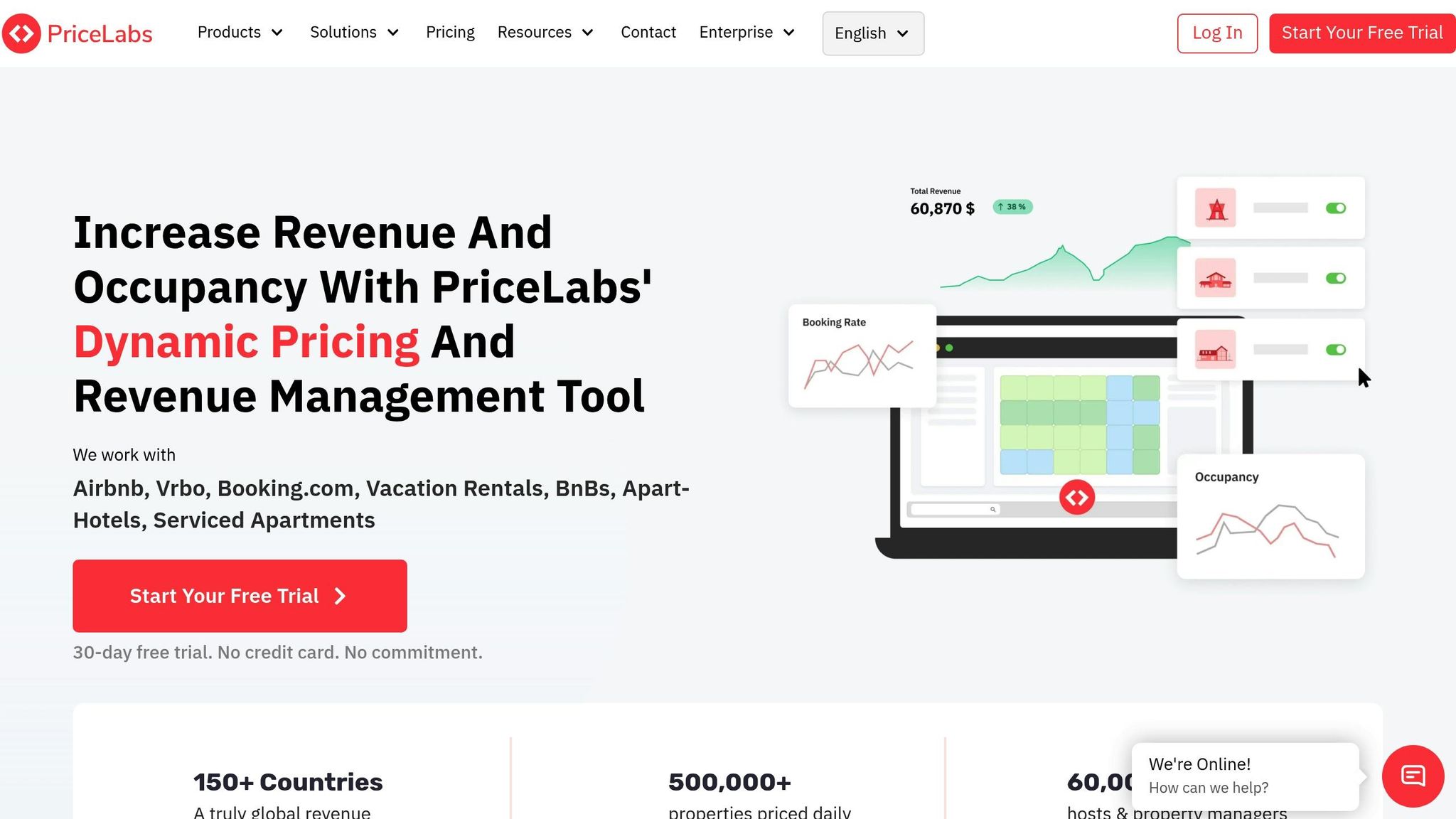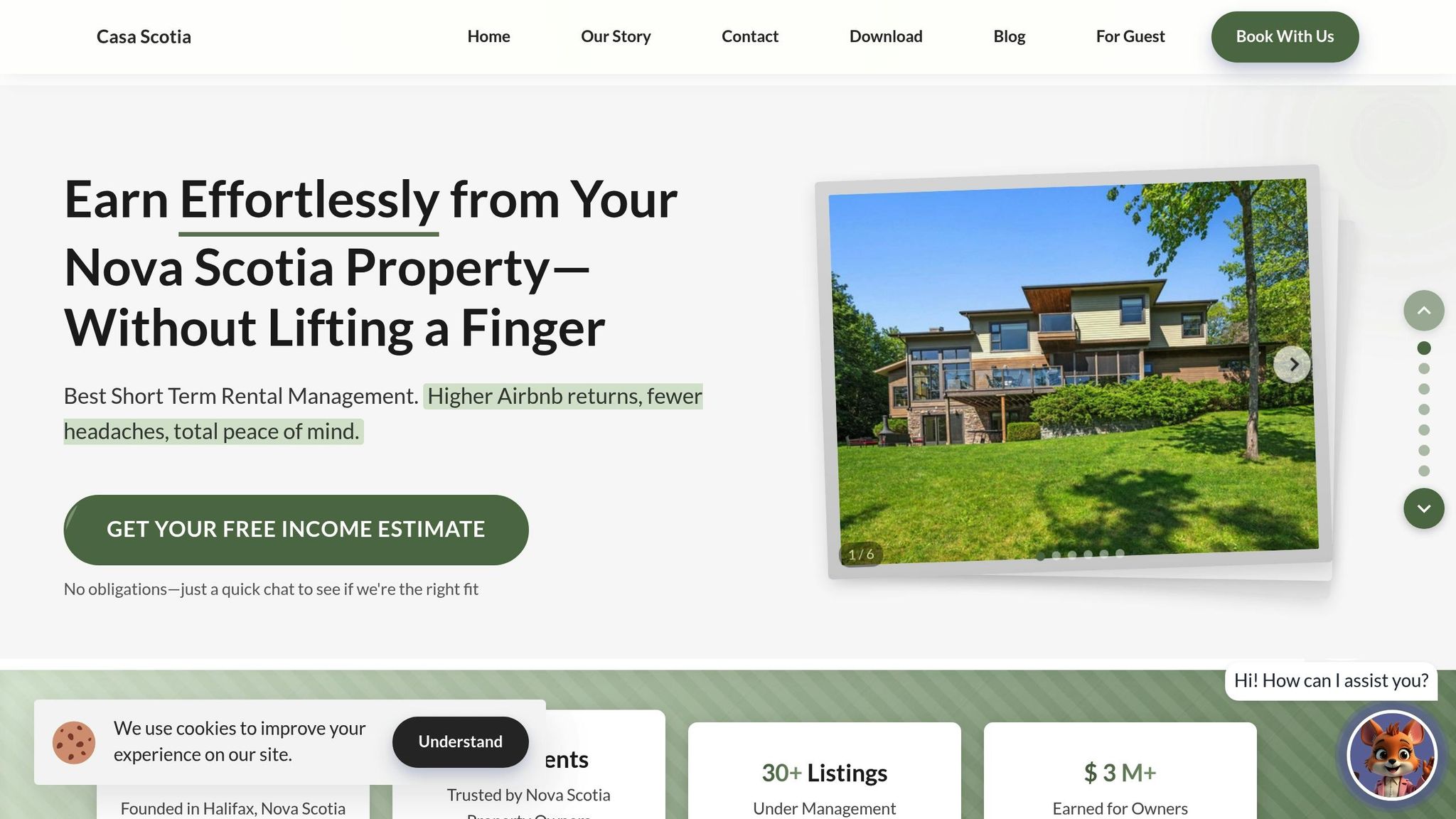Dynamic pricing is transforming how short-term rental (STR) owners in Nova Scotia set nightly rates. Instead of relying on fixed pricing, this strategy adjusts rates automatically based on market trends, demand, and events. Think of it like airline ticket pricing: rates shift in real time to match demand, helping you earn more during peak times and stay competitive during slower periods.
Here’s what you need to know:
- Why it matters: Fixed pricing can leave money on the table. Dynamic pricing helps you respond to demand changes, increasing revenue potential.
- Nova Scotia’s market: Seasonal tourism drives demand. Coastal rentals thrive in summer, while urban rentals in Halifax stay busier year-round. Events like the Halifax Jazz Festival or Cape Breton’s Celtic Colours spike demand.
- Tools to use: Platforms like Beyond Pricing and PriceLabs automate rate adjustments using data like local events and booking trends. Casa Scotia offers a local, hands-on solution tailored to Nova Scotia.
- Key strategies: Adjust rates for seasonal trends, offer last-minute deals, and track performance metrics like occupancy and average daily rate (ADR) to refine your approach.
Dynamic pricing ensures your rental stays competitive in Nova Scotia’s shifting market. Whether you manage a summer cottage or a city condo, the right tools and strategies can help you optimize revenue year-round.
Beginners Guide to Dynamic Pricing Software (Pricelabs)

Nova Scotia STR Market Overview
To navigate Nova Scotia's short-term rental (STR) market effectively, it's crucial to understand the province's unique landscape. With its tourism-driven economy, Nova Scotia experiences distinct seasonal trends that can significantly impact pricing strategies. Recognizing these patterns is the first step in setting competitive rates and maximizing revenue throughout the year. This overview provides the groundwork for the strategies and tools discussed later.
Seasonal Demand Patterns
Nova Scotia's STR market operates on a highly seasonal schedule. Coastal properties see their highest demand during the summer months, while the shoulder seasons - late spring and early fall - bring moderate activity. Winter bookings typically drop off unless tied to urban centres or specific seasonal events. Weather also plays a major role in short-term rental performance. Positive forecasts can drive last-minute reservations, while poor conditions often lead to cancellations.
Popular Regions and Property Types
The Halifax Regional Municipality is a cornerstone of Nova Scotia's STR market. Urban properties, such as downtown condos and apartments, attract both business and leisure travellers. Rentals near the waterfront or iconic landmarks often command higher rates due to their prime locations.
On the South Shore, waterfront cottages are a summer favourite, with destinations like Old Town Lunenburg drawing visitors thanks to their historic charm.
Cape Breton Island offers distinct opportunities, particularly along the scenic Cabot Trail. Rustic cabins and cottages in this area thrive during the summer tourism season and benefit further from cultural festivals that highlight the island's natural beauty and heritage.
The Annapolis Valley is a growing market, with its reputation for wineries and harvest events attracting visitors. Farm stays and rural properties in this region appeal to travellers looking for authentic Maritime experiences.
Across the province, the type of property can significantly affect performance. Entire homes tend to outperform shared accommodations, as guests value the privacy and full amenities they provide. Outdoor spaces, water views, and unique architectural features add to a property's appeal, while essentials like high-speed internet and modern kitchens are often non-negotiable for today’s travellers.
Local Regulations and Compliance
Nova Scotia's regulatory framework has a direct impact on STR operations and pricing. All hosts are required to register their properties and adhere to local licensing or zoning laws. These regulations can influence the supply of rental properties, which in turn affects pricing dynamics.
Tax obligations, including provincial sales tax and local accommodation fees, must be factored into pricing strategies to maintain profitability. Additionally, properties must meet safety standards, and many insurance providers require commercial coverage for STR operations, which adds to overall costs.
As regulations continue to evolve, staying informed is critical. Some municipalities may introduce seasonal restrictions or additional fees, requiring hosts to adjust their pricing calendars to remain compliant and profitable. A thorough understanding of these rules is essential before implementing dynamic pricing strategies.
Dynamic Pricing Tools and Solutions
Picking the right dynamic pricing tool can mean the difference between time-consuming manual adjustments and steady revenue growth. The market offers several platforms that automate pricing decisions using real-time data. For those in Nova Scotia, Casa Scotia stands out with its hands-off, locally tailored approach. Below, we break down the key features and advantages of popular tools and solutions.
Top Dynamic Pricing Tools for Nova Scotia
Beyond Pricing integrates directly with platforms like Airbnb and Vrbo, using a variety of market indicators - such as local events, weather conditions, and competitor rates - to adjust prices automatically. This allows Nova Scotia hosts to respond to demand surges during peak seasons without the need for constant monitoring.
PriceLabs focuses on detailed rate optimization and provides tools to fine-tune pricing based on market fluctuations. It connects seamlessly with your rental accounts, allowing you to set automation rules that align with your specific goals. Features like minimum-stay adjustments help cater to different booking patterns, whether for short weekend getaways or longer stays. Both platforms require an initial setup where you link your accounts, define your pricing strategy, and enable real-time price updates across multiple channels.
Casa Scotia's Dynamic Pricing Solutions

Casa Scotia takes a more localized and tailored approach, using dynamic pricing algorithms to maximize short-term rental revenue in Nova Scotia [1]. By leveraging AI-driven analysis of market trends and competitor pricing, Casa Scotia ensures properties achieve optimal occupancy and revenue [1][2]. Its expertise in the Nova Scotia market makes it uniquely positioned to handle the region's nuances.
What sets Casa Scotia apart is its combination of advanced pricing technology with hands-on local experience [1]. This approach includes not just dynamic pricing but also full-service management. Hosts benefit from transparent reporting and active price management that aligns with Nova Scotia’s seasonal demand and regulatory framework.
Comparing Features and Benefits
The best pricing tool for you depends on your management style and needs. Standalone tools like Beyond Pricing and PriceLabs provide automated, data-driven recommendations, leaving hosts to interpret and implement the insights themselves. On the other hand, Casa Scotia offers a fully integrated solution, combining dynamic pricing with property management. This means they handle everything - from monitoring to execution - making it an excellent choice for hosts managing multiple properties. By relying on their local expertise and hands-on service, Casa Scotia delivers a seamless, worry-free experience for property owners [1].
sbb-itb-b5e1074
Rate Adjustment Tactics That Work
To make the most of Nova Scotia's tourism patterns, dynamic pricing strategies should take full advantage of seasonal shifts. The province's tourism industry sees predictable highs and lows, making it an ideal environment for targeted pricing adjustments. Here's a closer look at how to tweak rates based on the season and for last-minute bookings.
Seasonal Rate Changes
Nova Scotia's tourism calendar is marked by clear seasonal patterns. During the summer months, particularly July and August, hotel occupancy rates soar to around 60–75%. But as the seasons change, those numbers drop significantly, with occupancy falling to 30–45% during late fall and winter months [4]. These fluctuations are also reflected in pricing - mid-range nightly rates in the summer are typically 25–40% higher than in November [4]. Adjusting rates to align with these trends can help maximize revenue during peak times and maintain competitiveness during slower periods.
Daily and Last-Minute Pricing Methods
Last-minute deals can be a game-changer for filling rooms. Offering discounts for bookings made on short notice - whether for "tonight", "this weekend", or "next weekend" - is a proven way to boost occupancy [3][5]. Since occupancy levels and demand can shift quickly, implementing daily and last-minute pricing adjustments ensures your rates stay competitive and relevant [4]. This flexibility can make all the difference in maintaining steady bookings year-round.
Financial Targets and Performance Tracking
Building on the dynamic pricing strategies we've explored, having clear financial targets and consistently tracking performance are key to boosting profitability. Without these elements, it becomes tough to gauge how well your pricing strategy is working.
Setting Revenue Goals
Start by figuring out your break-even point. Add up all your monthly expenses - things like mortgage payments, taxes, insurance, utilities, cleaning fees, and commissions. Once you've nailed down this baseline, factor in a profit margin that fits your business goals.
Your targets should also reflect the local market and your property's unique features. Is your property in a prime location? Does it have standout amenities? These factors can justify higher rates. Tailor your revenue goals by considering the break-even point, local demand, seasonal shifts, and what makes your property stand out.
Monitoring Key Performance Metrics
Keep a close eye on metrics like occupancy rate, average daily rate (ADR), and revenue per available night (RevPAR). The occupancy rate shows how often your property is booked, ADR highlights your earnings per night, and RevPAR combines these to give you a fuller picture of your revenue performance.
Booking lead times - how far in advance guests typically book - are another crucial metric. Understanding this can help you fine-tune your pricing for both early planners and last-minute bookings.
Casa Scotia’s owner portal simplifies this process by offering real-time access to these metrics through detailed monthly reports. With this data at your fingertips, you can spot trends early and tweak your pricing strategy to reflect real-world performance. Regularly reviewing these numbers lets you adjust targets as market conditions shift.
Adjusting for Seasonal Variations
Set separate revenue goals for peak and off-peak seasons. Use historical data and frequent metric reviews to adapt to changes in demand, weather, or special events in your area. These seasonal adjustments should work hand-in-hand with your overall dynamic pricing approach, ensuring your strategy remains flexible and effective.
Conclusion: Getting Results with Dynamic Pricing
Dynamic pricing provides a structured way to navigate Nova Scotia's market, helping you make the most of your earnings potential. By combining the right tools, strategies, and revenue objectives, you can build a pricing approach that works across the province's unique seasonal landscape.
Key Tools, Tactics, and Targets Summary
To succeed with dynamic pricing, you need a mix of automation, flexibility, and clear goals. Automated pricing tools help remove the guesswork, keeping your rates competitive as Nova Scotia's seasons shift. Adjusting rates for local events or peak travel times ensures you're capitalizing on demand, while defined revenue targets let you track your progress with precision.
Flexibility is a must. Whether it's offering last-minute deals to fill unsold inventory or holding firm on higher rates during high-demand periods, a balance of automation and manual adjustments is key. This approach ensures your pricing reflects both general trends and the unique circumstances of your property.
Setting clear revenue goals and monitoring performance metrics, such as occupancy and average daily rates, keeps your strategy on track. Tailoring these goals to peak and off-season periods, and factoring in your property's location and amenities, ensures your decisions are informed by data rather than guesswork.
Working with Casa Scotia
Casa Scotia takes these principles and applies them with expertise tailored to Nova Scotia's short-term rental market. Their management approach combines advanced pricing algorithms with deep local knowledge, ensuring your property performs at its best.
Nova Scotia's seasonal shifts demand a nuanced approach. Whether you're managing a waterfront home in Lunenburg during the bustling summer months or an urban rental in Halifax during the quieter winter season, Casa Scotia’s tools account for regional variations and events that generic pricing platforms might overlook.
For property owners ready to embrace a smarter pricing strategy, Casa Scotia offers two tailored options: Year-Round Management, which focuses on optimizing income throughout the year, and Peak-Season Management, ideal for hosts looking to maximize summer revenue while keeping the option for personal use. These services ensure your pricing strategy aligns with your goals and the opportunities in Nova Scotia's dynamic market.
FAQs
What are the benefits of using dynamic pricing for short-term rentals in Nova Scotia compared to fixed pricing?
Dynamic pricing is a game-changer for short-term rental owners in Nova Scotia, enabling them to adjust rates based on real-time market changes. By factoring in elements like seasonal demand, local events, and booking patterns, owners can increase revenue during peak periods while staying competitive during quieter times.
This strategy not only helps properties appeal to more potential guests but also ensures owners don’t miss out on earning opportunities when demand surges. Plus, by offering more attractive rates during slower periods, dynamic pricing can help fill vacancies, making it a smart approach for Nova Scotia's distinctive and ever-changing tourism market.
How can I adjust dynamic pricing for different seasons and events in Nova Scotia?
To set flexible and effective dynamic pricing for short-term rentals in Nova Scotia, focus on seasonal demand, local events, and market trends.
Take summer, for instance - it’s when Nova Scotia sees a surge in visitors, giving you the opportunity to charge higher rates. On the flip side, winter often brings fewer travellers, so lowering your prices might help maintain occupancy during those quieter months.
Local events, like festivals or sports tournaments, also play a big role. These can drive up demand, making it a perfect time to adjust your pricing and attract event attendees. At the same time, keeping an eye on market trends and what your competitors are charging will help ensure your rates stay attractive to potential guests.
By adapting to Nova Scotia's unique rhythms and market conditions, you can strike a balance between boosting revenue and keeping your calendar full.
How does Casa Scotia's local expertise help boost my short-term rental income in Nova Scotia's market?
Casa Scotia leverages its in-depth knowledge of Nova Scotia's market to help you boost your short-term rental income using dynamic pricing strategies. By carefully examining seasonal trends, local events, and shifting demand, they assist in setting rates that not only draw in guests but also enhance your revenue potential.
This personalized approach ensures your pricing reflects the unique characteristics of Nova Scotia's rental market, keeping you competitive. With their expertise, you’ll have the tools to make smart adjustments to your rates and improve your rental's overall profitability.



